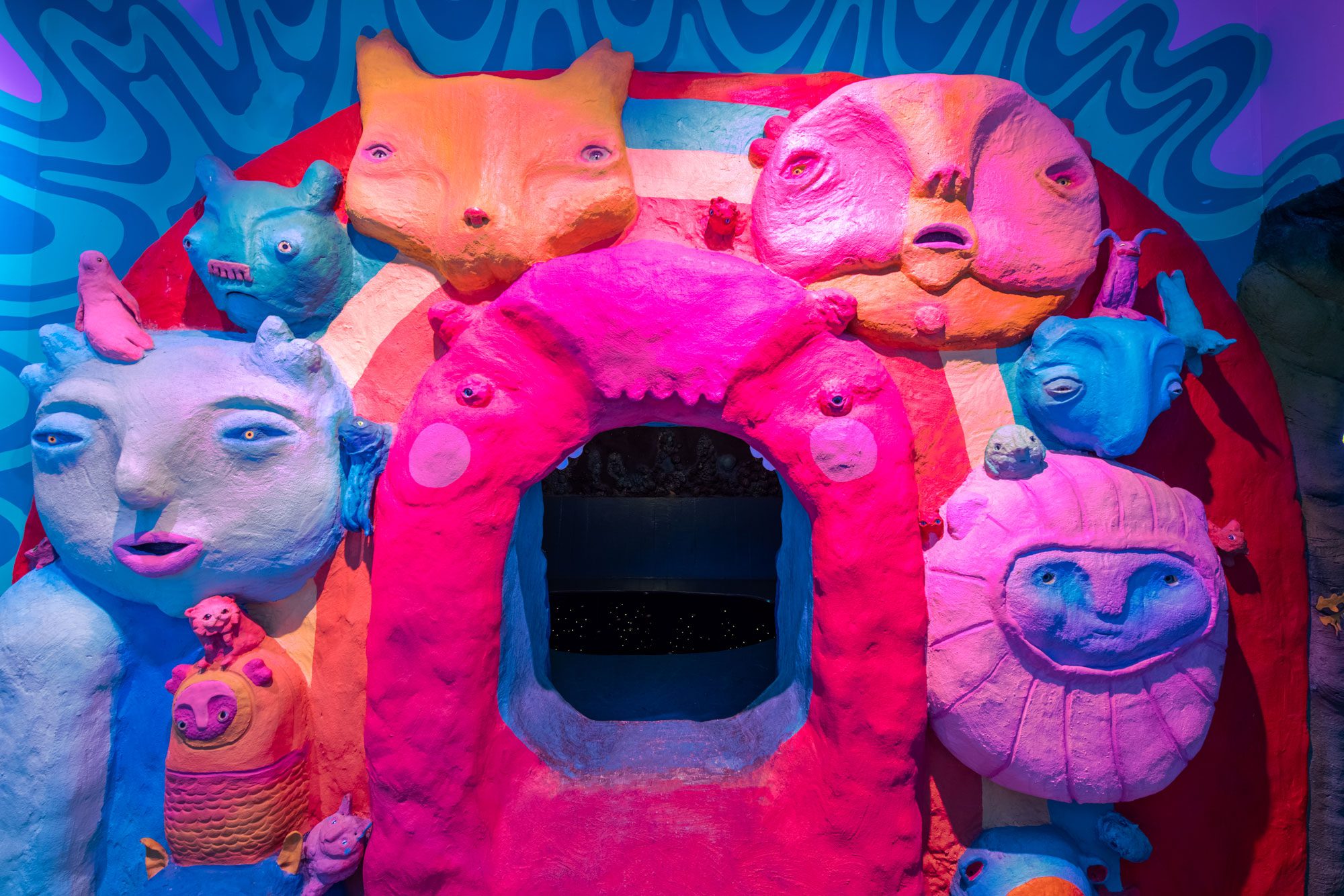
The Story Behind The Whimsical Animal Cave aka Womb Room
By Artist Jess Webb
Interview by Leah Clancy
Photos by Jess Bernstein
Published in Issue 121, January 2024
They started as simple doodles: Two-dimensional drawings, flat, in a graphic, illustrative style, no shading. But there these animals were. So, she talked to them. And like so many things within her artistic practice, they grew into themselves.
When Denver-based artist Jess Webb began the process of designing the Rainbow Room and the Womb Room for Convergence Station nearly four years ago, it was just a fledgling of an idea that lived in her mind. Something like an incubator, the space she envisioned was one of coziness and whimsy, both natural and supernatural, an imaginary drawn from elements of real life that felt familiar yet impossible, playful in their materiality, appearance and relationship.
Jess knew Meow Wolf in its formative years, prior to the permanent exhibition spaces, when it was a group of DIY artists in Santa Fe, NM. She recalls going to some of their shows: “One in particular was a geodesic dome structure that was filled with thrift store junk, it was so maximalist. You walked in and it was computers, stuffed animals, shoes — and I thought, This is amazing, I wish I could have a community like that in Denver that I could work with.”
It was during a Communikey (CMKY) Festival in Boulder, CO when Jess first met the group from Santa Fe. The connection continued from there, but her involvement couldn’t begin just yet. “When they started building House of Eternal Return, I was going to be involved, but I was single mom-ing at the time and I couldn’t go down to work on it. But a lot of my friends did … it came out to be such a neat thing.”
Jess’ background was one that drew her to Meow Wolf’s immersive artistic experiences. Her academic experience in both spacial media (“basically another way of saying ‘sculpture’”) and art education let her passions for working with people and natural material thrive. She’s focused on teaching within alternative spaces rather than in more traditional classrooms, such as Think 360, a Denver-based org that champions accessible arts education, where she’s worked with differently-abled artists of all ages.
Like many other Meow Wolf artists, she’s been connected to the fine arts world, completing residencies and gallery shows. However, also like many other Meow Wolf artists, she’s never limited herself to one type of creative practice. Rather than thinking of it as artwork, she likes to think of it as artplay. Her career experiences have ranged from interior design and custom installation, to creative direction and film production for music videos. She makes paintings and ambient music; she designs earthware and jewelry; she uses textiles and wood and plants.
“When I found out they were building one in Denver, I was ecstatic. I felt like it was a long time coming.”
Early on in the development process, Jess began working with Meow Wolf Co-Founder and Senior Creative Director Caity Kennedy. After pitching her idea of the Womb Room, she learned her installation would exist in Numina, a sentient universe that is just as much a living being as it is a place.
At first, when the Womb Room existed only as collaged planning sketches and in Jess’ mind, “… it was going to have a net, a place you could lay down in — it was going to be a cushy area with pillows.” But between the emergence of COVID, budget constraints and fire code requirements, her plans shifted. “We had to change a lot of things.”
The core of her idea remained the same, to create a place that felt like the beginning of life and time. But all of the materiality changed. “I started rethinking the use [of the room] — how many people were going to be in that space, touching things — it just seemed smarter to move away from fabrics and textiles, and more towards harder washable surfaces.”
“Originally everything was going to be made out of fabric and cloth and giant stuffed animals essentially. Then we sort of leaned towards a sculptable concrete instead, with the Rainbow Room specifically.”
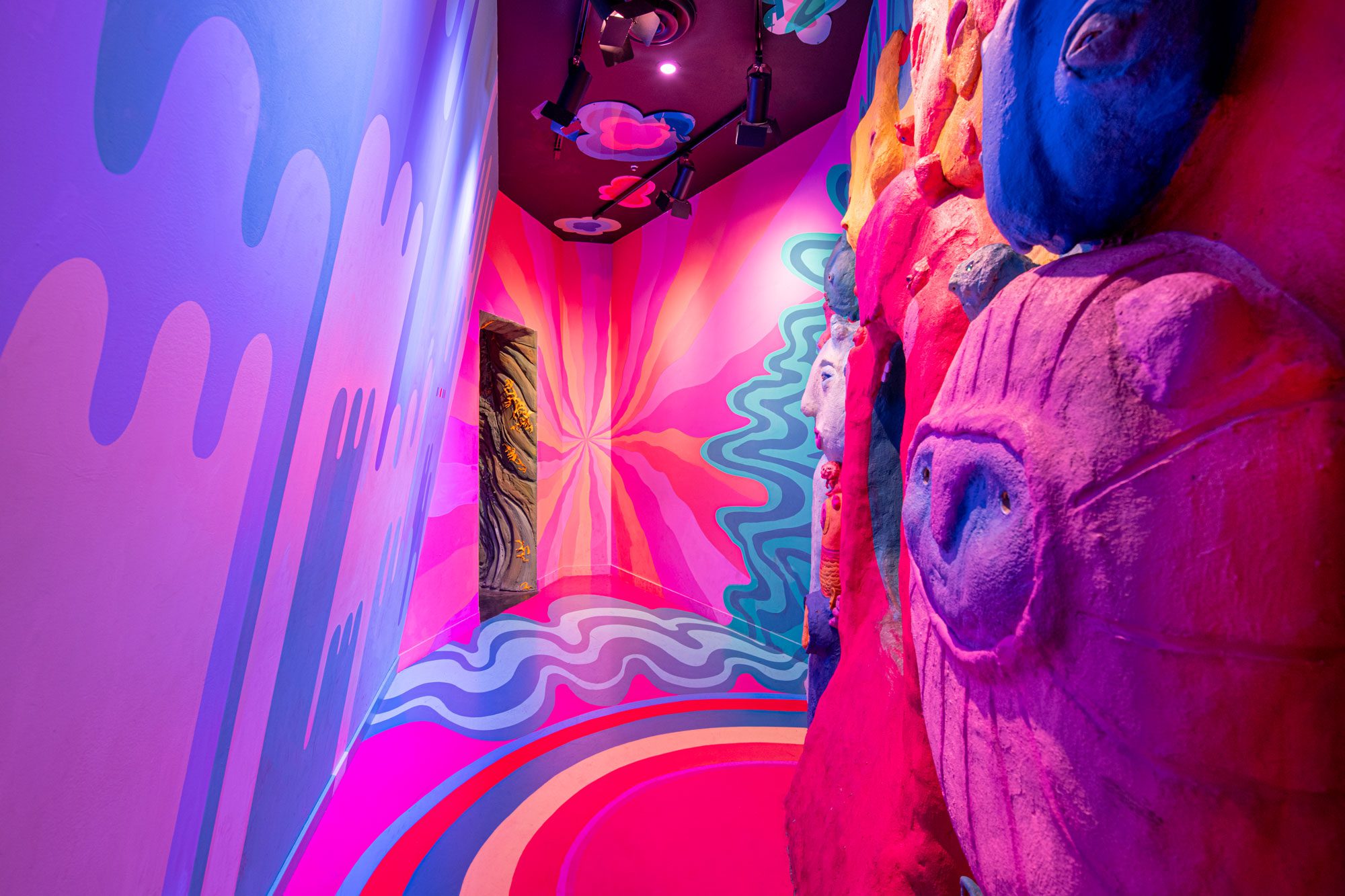
RAINBOW ROOM/CREATURES
The Rainbow Room is a candy-colored psychedelic vestibule to the Womb Room. Her creatures, once just doodles, surround the portal. They huddle around the entrance, not quite greeting visitors but not quite warding them off either; their expressions range from bemused to skeptical, to indifferent. “I know the one on the left is really grumpy,” says Jess.
As she developed her initial doodles, these otherworldly animals took on personalities of their own. Jess felt she could talk to them; they even had names. “The one on the bottom left was one of the first ones that I made, her name is Etta. It’s blue with a yellow face, and ears that come out, and she’s just, like, kind of pathetic and depressed, but I just love her.” As she sculpted and hand painted them, she got to know them more.
These animals are reminiscent of Jim Henson characters, specifically from the movie Labyrinth (1986), in which a lycra-clad David Bowie is the king of goblins who snatches away a young girl’s baby brother. In her effort to rescue the child from a seemingly infinite labyrinth by midnight, she encounters a hodgepodge of fantastical beasts and critters. Some are tricksters, and some want to help.
Jess said that she was “obsessed” with the movie as a kid, and his characters served as very strong inspiration. “There’s one creature that’s up to the right that is kind of ugly, with a wrinkly double-chin going on. That definitely references the door-knocker character [in the film].”
As she shifted to incorporating different media, her stuffed animals transformed into concrete and plaster. In their transformation from sketches to sculptures, Jess wanted to play with the push and pull between two- and three-dimensional objects, letting them emerge from the walls while retaining some of their flat quality.
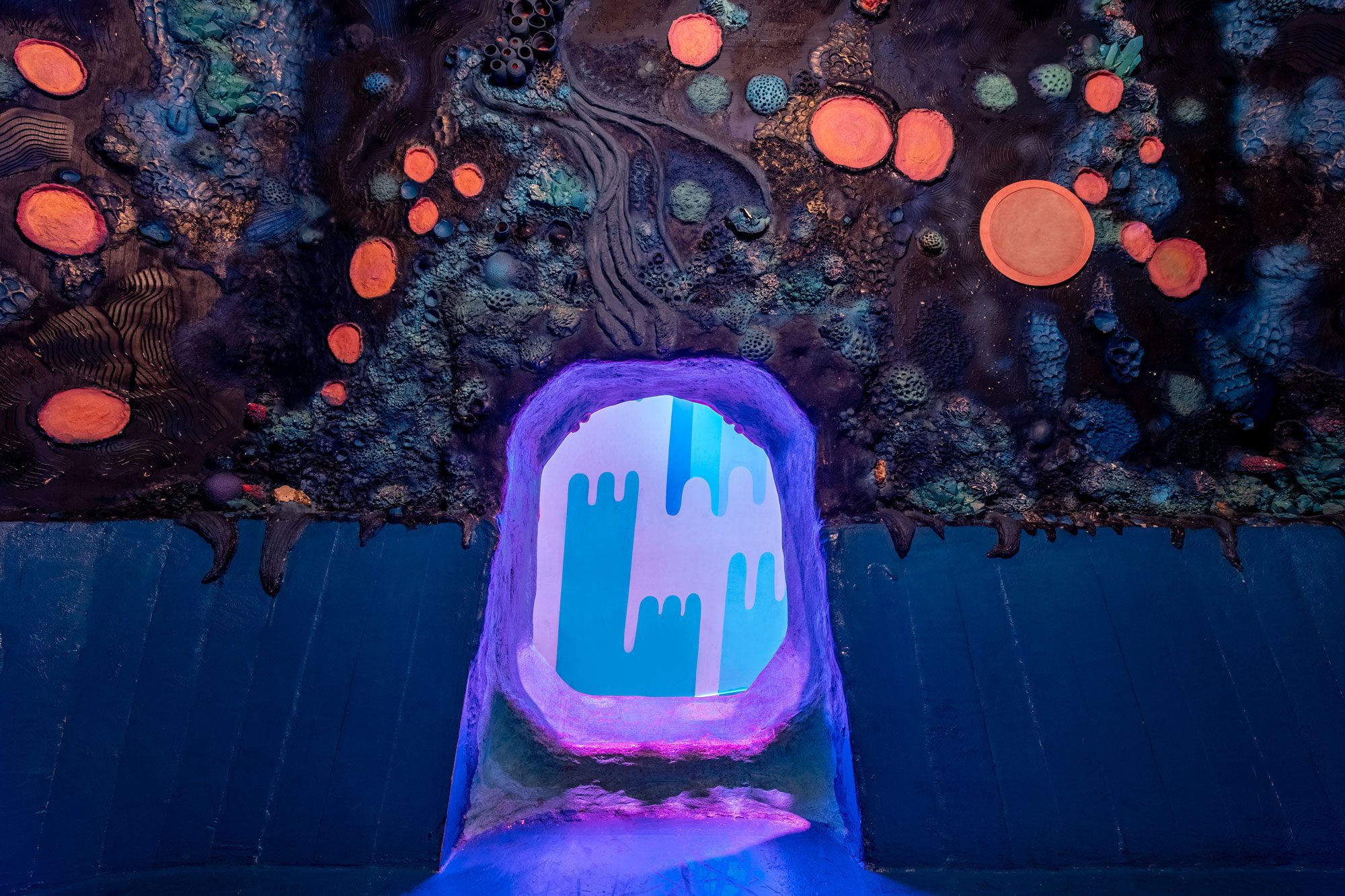
WOMB ROOM
It’s fitting then that her animals exist between two different planes, as they also act as a welcoming committee to a new world: a chrysalis, a gateway between other spacial dimensions, where one can go backwards and forwards as they please. Entering into the Womb Room is transformative — suddenly you find yourself crawling like an infant into a starry nexus of multi-universal life. Mirrors reflect speckled light, crystalline structures refract a swampy twilight haze. Soak up the warmth of the intergalactic primordial soup.
Across all of Jess’ artistic disciplines, there is a common denominator: “I draw a lot of inspiration from nature and patterns in nature, so it was important to have that element be a part of it.” Not just incorporated into the imagery, nature was also deeply connected to the materiality and process of forming the Womb Room. “I made a lot of casts of crystals, fruits and vegetables — cucumbers, romanesca, bananas … and cupcakes.”
Instead of plastics or silicone, Jess opted for cement mixtures and plaster to cover the cavernous walls in organic textures and shapes reminiscent of barnacles, tree bark and mineral formations. Much of the paint she used was made from natural pigments, including ammonite — fossilized mollusks from the Late Cretaceous period that are naturally found in Colorado.
Within the decision to use natural sculpting materials comes a relevant experiment: She’s unsure of how they’ll hold up. “I’m pretty relaxed about how things wear and tear … But it’s the nature of the space. The Womb Room is an organic space so if you were to add elements to it or take elements away, it can transform a bit. It’s its own natural cave, and it’s still going to hold the concept as time changes it and people touch it.”
And Jess didn’t have to forsake her textile dreams entirely: She used felt “to create weird organic things … that live on the ceiling.” Among them, you’ll find little creatures hiding in there that she let her daughter paint. So, her animals make an appearance in the room as well. “My favorite creature is inside … he’s like a little Buddha in the corner, he’s blue, and that’s my favorite one for sure. I wish I made casts of them so that I could make a million of them.”
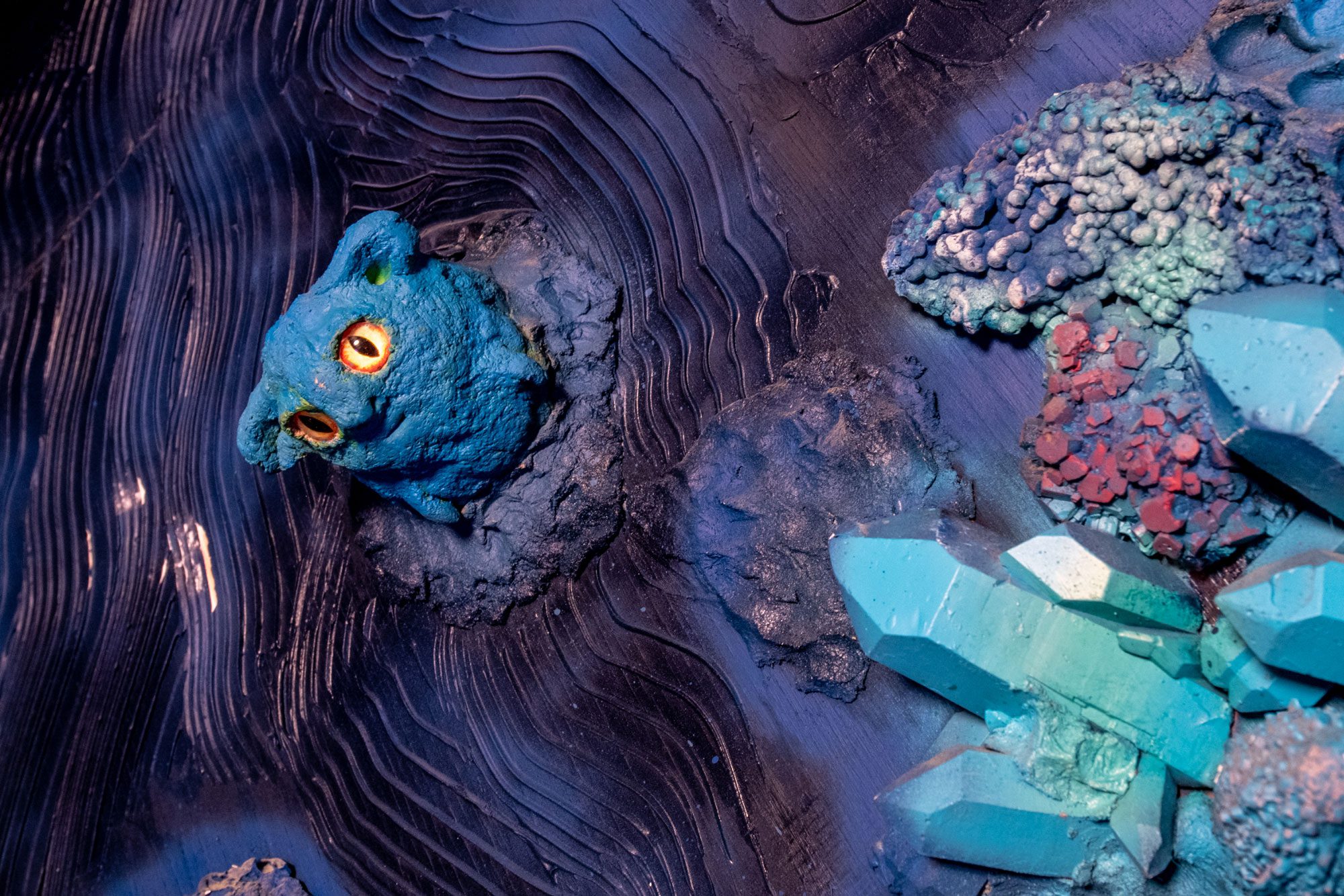
SOUND
Since so many elements of her installation gesture towards the formation of life, she gave it a heartbeat.
Like Numina, one of Convergence Station’s four worlds, both of Jess’ rooms are multisensory experiences, and sound plays a major role in creating a whimsical, surreal atmosphere. In her ambient music practice, she collaborates with her husband, Paul, under the title Saskatoon, and uses field recordings in her work.
For the Rainbow Room, Jess again had her daughter pitch in, recording her as she made “crittery, creepy sounds” for the creatures; she then passed the audio on to her husband, who added delay, echo and reverb to make them even creepier.
Sound was very important to her, especially its movement. “I wanted it to be very visceral, I wanted there to be a lot of bass, and a lot of movement of sound, bouncing sound through the speakers throughout the room to have it feel like a realistic atmosphere.” Gleefully, she mentions that there’s a “really big subwoofer.”
Pulling from Saskatoon’s aesthetic, Jess produced a 17-minute track with Paul, directing the piece in the direction of Erik Satie and Brain Eno, ranging from classical to instrumental music not unlike a soundtrack for a meditation, “… but not New Age-y, hopefully.”
It’s a tender piece of music that loops, reminiscent of bands like Explosions in the Sky and Boards of Canada, and composers like Joe Hisaishi and Yann Tiersen. Throughout it, there’s a heartbeat for the creature of the universe, purposely set outside of the rhythm of the music: “It’s supposed to be a found sound.”
A rise and fall of piano provide a wistful melody, twinkles of running water trickle through, strings echo like thoughts inside the cavern, and a gentle lull of bass glows with warmth. “This room is influenced by the moment when you’re underwater and sound is different, and everything feels like it’s moving in slow motion — I wanted that feeling, where everything’s cozy and safe. I mean, it’s the Womb Room!”
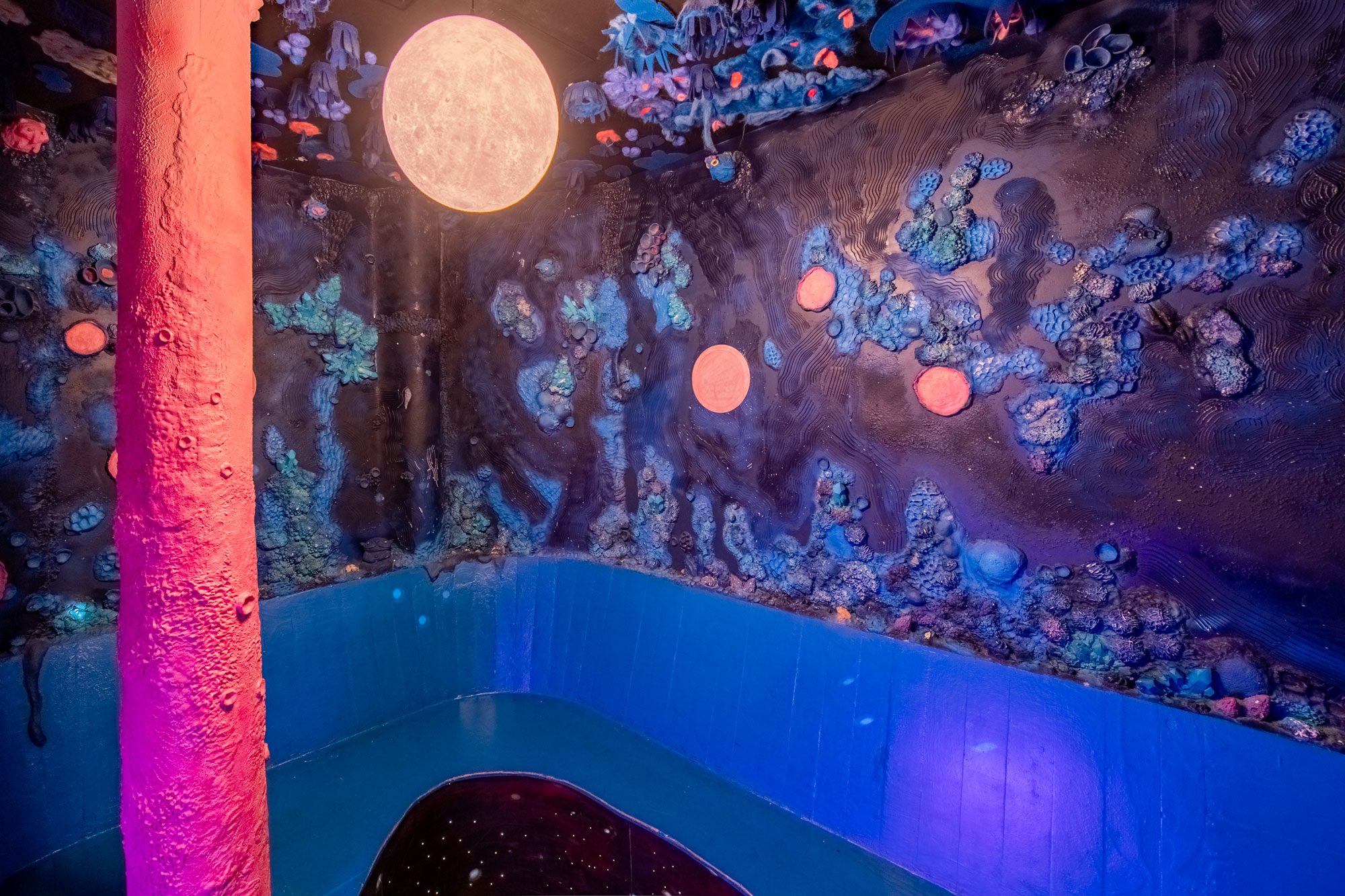
COMPLETION
Jess’ process of developing the Rainbow Room and the Womb Room is fitting — an inkling of an idea birthed, imaginary animals gestated and come to life, a universal cosmic heart given its beat — it was built by acts of creation to represent, well, creation.
“I was one of the first artist contractors working in the space … It was an industrial skeleton.” There was steel and concrete. But once she returned before the official opening in September 2021, she saw the transformation. She walked in and thought, “Oh wow, they really did it again. It’s just so magical. Being a part of something that’s really creative in this way is such an honor.”
And while she was unable to contribute to House of Eternal Return in 2016, the family she was building at the time helped her build an entire origin of worlds within two rooms. “I was really excited to bring my husband and my daughter to this space because their voices and music and work were really a part of it. Sitting in the Womb Room and listening to the music and being in that space [with them] was really special, and so wholesome … it was really sweet.”
Now, on the other side of the process, she feels a natural completion: “When I first began working with Caity, I told her what my idea was with the Womb Room and the animal heads. And I think that my vision came through. Everything that I set out to do, I did. It’s cool to see that come to fruition.” Jess invites visitors to “become their 4-year-old self” within her space. And it lets you do just that.
Meet these creatures and more at Convergence Station in Denver, CO
Check out other portals near you: near you: House of Eternal Return in Santa Fe, NM | Convergence Station in Denver, CO | Omega Mart in Las Vegas, NV | The Real Unreal in Grapevine, TX | And coming soon … Houston, TX!
This feature was produced in partnership with Meow Wolf.
Check out Meow Wolf’s December Birdy install, Take A Tour of Tiny Meow Wolf by Jena Braziel, or head to our Explore section for more of their past published pieces.

Pingback: Walkabout: Mini Golf by Meow Wolf x Mighty Coconut by Rivka Yeker - BIRDY MAGAZINE